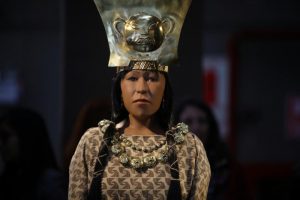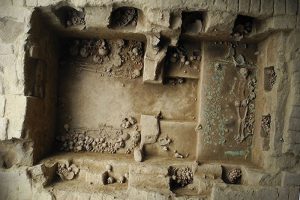When most people think of archaeology, the picture that comes to mind is more-often-than-not one closer to that of Indiana Jones than to that of Lara Croft. Despite both characters existing on a fictional spectrum, this observation of how such popular media culture is represented and absorbed by the general public is an example of a much bigger problem within the field of archaeology itself: androcentrism and the male bias.
Excavations of the Moche civilization in San José de Moro, Peru that inhabited the area between 1 CE and 800 CE have been taking place for decades. But in the past 27 years, up to eight notable tombs have been discovered in what was once thought of as a society consisting of only male warriors, priests, and kings. Tomb after tomb, archaeologists’ preconceived notions of the civilization’s societal composition were put to the test and quickly fell apart. In 2006, archaeologists were shocked to come across a lavishly decorated tomb on the El Brujo site filled with the remains of—you guessed it—a woman. The findings from a burial analysis of her mummified skeleton and the artifacts deposited in her grave—buried with wooden scepters wrapped in copper, a large crown with an image of a puma, and several tattoos symbolizing sacred figures including snakes, spiders, trees, and stars—led archaeologists to believe that she lived as a high priestess or even a queen of the Moche people. She was later referred to as the Lady of Cao, her burial’s discovery only to be followed by seven additional discoveries of other burial sites of women. The mummies adorned extravagant headdresses and beaded necklaces, were buried next to sacrificed victims, and were surrounded by grand artifacts including scepters and goblets that indicated that they, too, were of higher status and had possessed a more prominent role in the Moche society.

A reconstructed 3D-printed replica of the face of the Lady of Cao, a female priestess-queen of the Moche civilization.
The impact of androcentrism in archaeology is thoroughly and explicitly exemplified in the long-held assumption by archaeologists that the Moche society was ruled only by male figures; with further analysis of the burial sites, findings implied that the buried Moche women belonged to a higher social class, further breaking the notion that the Moche civilization exclusively comprised of higher orders of men and, rather, included—or more often comprised of—women as social elites.

The tomb of the eighth Moche priestess to be discovered, buried 1,200 years ago with an array of artifacts that indicates her high social status.
The discoveries of the priestess-queens of the Moche remind us that we must stay aware of our presumptions and biases as they often bring us to incorrect conclusions. As archaeology is still developing when it comes to including, recognizing, and rewarding women, the male bias is especially important to keep in mind when considering historical archaeological conclusions about the role of gender in ancient societies and cultures. With an awareness of the biases of not only ourselves but also those of archaeologists before us, we can make sure that we are not discounting any potentialities on a matter of assumption or misinterpretation of evidence and that we are, instead, taking into consideration all possibilities in order to accurately restore the archaeological record.
Sources
Renfrew, Colin, and Paul Bahn 2010 Archaeology Essentials. 2nd ed. Thames & Hudson, New York.
Excavated Tombs of Peru’s Moche Priestesses Provide Archaeologists with Troves of Artifacts, Data
Lady of Cao Comes to Life: Face of Peruvian Priestess Reconstructed from 1,700-Year-Old Mummy
The Lady of Cao and the Royal Tomb Images Source
Additional Readings
Tomb of a Powerful Moche Priestess-Queen Found in Peru
1,500-year-old Ruins Shed Light on Peru’s Mysterious Moche People

